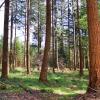14 July 2023
IIASA researchers Juliana Arbelaez-Gaviria and Eleanor Warren-Thomas have coauthored a new policy brief published with the Colombia team of the Food, Agriculture, Biodiversity, Land, and Energy (FABLE) Consortium, an initiative under the Food and Land Use Coalition (FOLU) and part of the UN Sustainable Development and Solutions Network (UNSDSN). The brief outlines how deforestation and ecological restoration in Colombia may impact carbon, biodiversity, and agricultural production by 2030.



